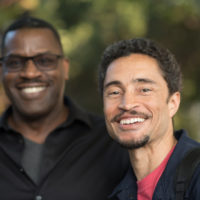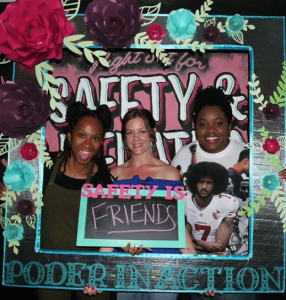As calls to #defundthepolice reach the budget proposals of local and state decision-makers, we are reminded of the prescient call of NCRP members like the Ella Baker Center. In the wake of the murder of Trayvon Martin in 2014, the Oakland, California-based nonprofit started a national campaign that has grown to hundreds of community events in more than 30 cities to reimagine the meaning safety and security.

Ella Baker Center Executive Director Zach Norris (right), with a community member, at the 2019 Night Out for Safety and Liberation in Oakland. Photo by Brooke Anderson, courtesy of Ella Baker Center.
The Night Out for Safety and Liberation was an alternative take on the National Night Out, an effort that started in the 1990s that encouraged vulnerable communities to work together and stand up against violence and crime.
This year, the main sponsors of the event, the National Association of Town Watch has put off the annual August event in light of social distance constraints of COVID-19. While it’s a decision that Ella Baker Center Executive Director Zach Norris generally agrees with, he can’t help but wonder whether the nation’s COVID-19 crisis would be limited if we approached safety “with public health in mind instead of ‘see something, say something’ vision.”
We asked Norris to tell us a little bit more about the National Night Out for Safety and Liberation and what it means to boldly reimagine safety in the wake of the coronavirus pandemic and the uprisings against police brutality. A much longer written piece about this can be found here.
Elbert Garcia: Why do you think we need a public health safety approach to safety?
Zach Norris: A public health approach to safety recognizes that all of our safety is tied to each other. It is the idea that our overall community health can only ever be as good as the health of our most distressed communities. For example, a public health approach to safety would empower first responders who are trained to deal with mental health issues, drug use and abuse, homelessness and school discipline rather than sending in armed police.

Community members reimagine what safety is at the 2019 Night Out for Safety and Liberation event hosted by Poder in Action in Phoenix, Arizona. Photo courtesy of Poder in Action.
EG: Why is the current National Night Out problematic?
ZN: The vision of safety promoted at National Night Out has been more grounded in fear and suspicion than in this public health orientation. Don’t get me wrong, the spirit of everyday people coming together to ensure their communities are safe is laudable. But the silence of National Night Out event organizers in the face of the exposure of a long history of police violence in communities of color is deafening. The event website does not mention police violence, nor police brutality, nor any statement acknowledging the ongoing trauma police have caused Black communities.
The main message from police to community members is “you are the eyes and ears of the police.” When police promote these messages, they tap into centuries of social conditioning that lead white people as well as people of color to believe that Black and brown people constitute a threat. An overwhelming focus on watching our neighbors with suspicion, rather than seeing them, can be deadly.
EG: What message do you instead want to deliver with the National Night Out for Safety and Liberation?
ZN: At these events, we remind people that they don’t just have eyes and ears, that they also have hearts, hands and minds. We describe the myriad ways and reasons people feel unsafe; restaurant workers who can’t put food on their own tables, transgender women who are afraid to walk out of their homes. We also describe the many ways people contribute to community safety, that mentoring a young person, providing a job to a formerly incarcerated person and participating on the local water or school board are all ways to contribute to community safety.
EG: What are some places that should get funded, instead of law enforcement heavy tactics?
ZN: There are so many viable, effective safety solutions that are under-resourced or nearly unknown. In California’s East Bay, Restore Oakland is a new community center that demonstrates what public safety looks like by making job training, restorative justice and organizing resources available to the public. In Richmond, California, Advance Peace is a highly effective gun-violence prevention effort which can and should be replicated in every city in the country.
Universal health care and child care are also public safety interventions that would help stem the spread of illnesses such as the coronavirus while also providing families with the support they need to help break cycles of poverty, addiction and incarceration.
Click here to read more about Zach’s vision for Night Out for Safety and Liberation
Top Photo: A young boy performs at the 2019 Night Out for Safety and Liberation in Oakland, California, a national event organized by the Ella Baker Center on the first Tuesday of August. Photo by Brooke Anderson, courtesy of Ella Baker Center.














































































































































































































































































































































































































Leave a Reply